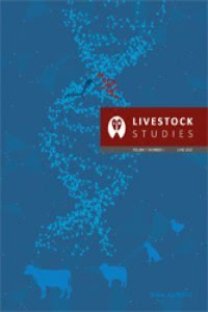DAMIZLIK BILDIRCIN RASYONLARINA ENERJİ KAYNAĞI OLARAK BİTKİSEL VE HAYVANSAL KÖKENLİ YAĞ KATILMASININ ÜREME PERFORMANSI VE YEM DEĞERLENDİRME ÜZERİNE ETKİLERİ
Bu araştırmada, yumurtlama dönemindeki bıldırcın rasyonlarına farklı seviyelerde bitkisel ve hayvansal yağ katılmasının, hayvanlarda yumurta randımanı, yem tüketimi, yem değerlendirme sayısı, kuluçka randımanı, döllülük oranı ve çıkış gücüne etkileri incelenmiştir. 16 hafta devam eden bu deneme, 5 grupta yürütülmüştür. Kontrol grubu yağ katkısız hazırlanmış diğer gruplara, sırasıyla, % 2 ve % 4 seviyelerinde bitkisel yağ, % 2 ve % 4 seviyelerinde hayvansal yağ katılmıştır. Bu denemede gruplardan saptanan ortalama yumurta verimi sırasıyla, 73.45 %, 72.65 %, 75.81 %, 69.99 % ve 71.41 %; ortalama yem tüketimi 27.51 g, 28.10 g,. 26.61 g., 27.70 g., ve 29.82 g; ortalama yem değerlendirme sayısı 5.97, 6.21, 5.37, 6.55 ve 6.48 olarak bulunmuştur. Gruplar arasında istatistiki bakımdan önemli bir farklılık ortaya çıkmamıştır. Denemede ortalama kuluçka randımanı sırasıyla, % 60.00, 61.43, % 60.84, % 61.21 ve % 60.00; ortalama döllülük oranı % 88.33, % 84.17, % 84.17, % 83.34 ve % 80.00; ortalama çıkış gücü % 67.52, % 72.30, % 72.23, % 72.47 ve % 73.77 olarak saptanmıştır. Gruplar arasında istitistik bakımdan önemli farklılık gözlenmemiştir.
Effects of Adding Different Levels of Vegetable Oil and Animal Fat As an Energy Source to Breeding Quail Rations on the Reproductive Performance and Feed Efficiency
The experiment was conducted to study effects of different levels of vegetable oil and animal fat as sources of energy on the reproductive performance of the Japanese Quials in the egg production period that continued 16 weeks. Five groups of the animals were forme in this experiment. One of them was control and the other four were experimental groups. The animals in the experimental groups were fed rations that contained 2 % and 4 % vegetable oil or animal fat, respectively. Egg production of control and experimental groups were 73.45 %, 72.65 %, 75.81 %, 69.99 % and 71.41 % respectively. Feed consumption and feed efficiency of groups were 27.51 g, 28.10 g, 26.61 g., 27.70 g, and 29.82 g; and 5.97, 6.21, 5.37, 6.55 and 6.48 respectively .The differents among the egg production, feed consumption and feed efficiency of groups were not statistically significiant. Hatchabilty of groups 60.00 %, 61.43 %, 60.84 %, 61.21 % and 60.00 % respectively. Fertility and fertile eggs of hatch of groups were 88.33 %, 84.17 %, 84.17 %, 83.34 % and 80.00 % with 67.52 %, 72.30 %, 72.23 %, 72.47 % and 73.77 % respectively. The differents the among hatchability, fertility and fertile eggs of hatch of groups were not statisticaly significiant
- Yayın Aralığı: Yılda 2 Sayı
- Başlangıç: 1959
- Yayıncı: Sezer ÖZ
Sayıdaki Diğer Makaleler
Abdulhadi BAŞARAN, Abdulkadir AKCAN
Ö. Faruk ALARSLAN, Ekin TOKER, Muzaffer ÇÖRDÜK
Ceyhan ÖZBEYAZ, Cumali BAĞCI, Tahsin YAĞCI, Orhan ALPAN
HAYVAN BESLEMEDE ASKORBİK ASİDİN ÖNEMİ
Nurcan ÇETİNKAYA, Sabiha ÜNAL, Aziz ÖZTÜRK
HOROZLARDA SPERMA KALİTESİNİN DEĞERLENDİRİLMESİ
Ongun KESKİN, Necmettin TEKİN, Nafiz YURDAYDIN, Murat SELÇUK, Mustafa KAYA
KUZULARDA BÜYÜMEYİ ETKİLEYEN ÇEVRESEL FAKTÖRLERİN KOVARYANS ANALİZİ İLE İNCELENMESİ
